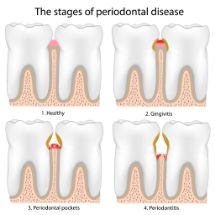
The Centers For Disease Control estimate that nearly 65 million Americans have some form of gum disease (also called periodontal disease). Most people know how important it is to have healthy teeth but don’t spend much time thinking about their gums. This common condition causes inflammation of the gums and underlying bone that surround the teeth and can have serious consequences, including tooth loss. The first step to overcoming gum disease is having the right information about it, so keep reading to learn the truth about 5 common myths you may have heard.
1. “Gum Disease Is Painful”
Surprisingly, gum disease isn’t painful. In fact, it’s often called a “silent disease,” much like high blood pressure, because people don’t feel it. However, there are signs to be aware of, including tender or bleeding gums, chronic bad breath, receding gums, painful chewing, and loose teeth.
If you notice any of these symptoms, schedule a checkup right away to have your gums examined. Gum disease can’t be cured, but it can be treated to keep it from progressing. Having said that, it’s important to note that treatment is more effective in the earlier stages.
2. “Gum Disease Only Affects Your Oral Health”
While advanced gum disease does lead to tooth loss, there have been countless studies showing that it also increases your risk of:
- Heart disease
- Some cancers
- Stroke
- Diabetes
- Alzheimer’s disease and other types of dementia
- Pregnancy complications like preterm birth and low birth weight
3. “If You Don’t Have Cavities, You Don’t Have Gum Disease”
Cavities and gum disease are separate, unrelated issues. The type of bacteria that causes cavities (Streptococcus mutans) is different from the type that causes gum disease (Porphyromonas gingivalis). In fact, teeth that have never had cavities can still become loose and fall out if the surrounding gum and underlying bone are damaged by advanced gum disease.
4. “Good Brushing and Flossing Can Prevent Gum Disease”
While brushing and flossing are certainly crucial for managing gum disease, it can’t always prevent it. Unfortunately, “pockets” of gum tissue around each tooth become deeper as gum disease progresses. Once they’re deeper than 4mm, it’s impossible to reach the plaque, bacteria and tartar under the gums with a toothbrush and floss. At this point, professional cleanings and gum disease treatment are necessary.
In addition, genetics, smoking, and diabetes can also increase your chance of having gum disease, regardless of how good your brushing and flossing are.
5. “Gum Disease Can Be Cured”
The earliest stage of gum disease is called gingivitis (which means “inflamed gums”), and it can be reversed with regular cleanings and excellent oral hygiene at home. However, once it progresses past gingivitis, gum disease can only be managed – not cured. Fortunately, there are effective periodontal treatments that can stabilize it and greatly lower your risk of tooth loss and general health problems.
Do You Have Gum Disease?
The first step to having healthy gums is getting them examined. If you are diagnosed with gum disease, you can be proactive and get treatment right away. This will give you a better chance of keeping your teeth well into old age and also staying healthier overall!
About the Author
Dr. Mark Hochman is a family dentist with over 40 years of experience who’s passionate about his job. With an understanding of how important gum health is, he always educates his patients about the risks, symptoms, and treatment options for gum disease. If you have any questions about gum disease or believe you might already have it, he can be reached through his website.
 La
Plata
La
Plata